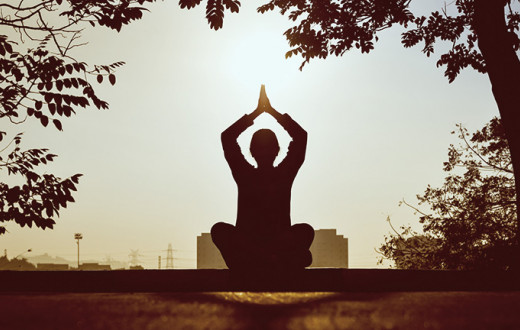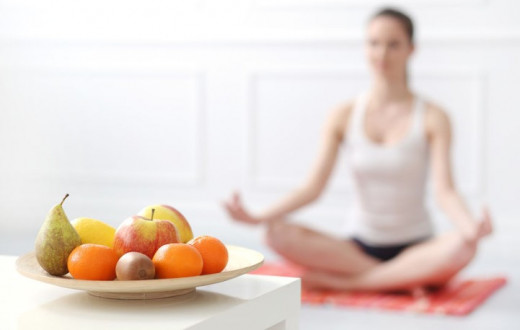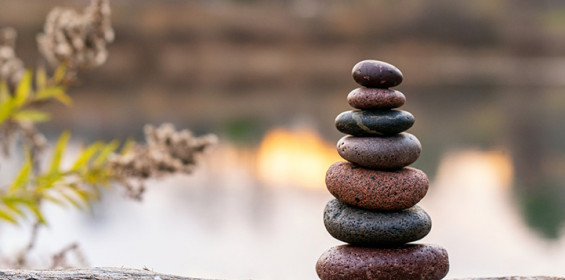By Sejal Shah┃Posted: April 2, 2019
Most of us have had days when we wake up on the wrong side of the bed, and then everything seems to go wrong from there. How we wake in the morning definitely seems to set the tone for the rest of our day. It’s also true that how we spend the day has an effect on the evening and the night. Setting a daily routine that involves starting your day with positive feelings, thoughts, and energy ensures that everything else falls into place, and that you can enjoy a productive, creative, fulfilling day, as well as a relaxing, rejuvenating night. There are many benefits of practicing daily rituals, and the importance of having a daily ritual has been emphasized in many cultures and healing sciences, including yoga and Ayurveda.
In Sanskrit (an ancient Indian language), the daily routine is called the Dinacharya. ‘Din’ means 'day', and ‘acharya’ means 'to follow' or 'close to'. So, Dinacharya is an ideal daily schedule taking into account the cycles of nature. In Ayurveda, the focus is levied on the early hours of the day, as it is instrumental in setting the tone of your day.
Ayurveda believes that routine is a discipline for the body and mind that strengthens immunity and purifies the body of waste. With the help of simple, healthy routines, one can clean the body and mind, balance doshas, strengthen immunity, and start the day on a refreshing and rejuvenating note.
Following a simple routine in the morning will help you start the day on a blissful note. Here is your guide to a refreshing morning inspired by the two ancient sister sciences of Yoga and Ayurveda.
1. Wake up during the Brahma muhurata
Try to wake up an hour and a half before the sunrise, so that you can synchronize with the rhythm of the sun. Ayurveda recommends an ideal time - ‘Brahma-muhurata’, which means ‘the time of Brahma…the pure consciousnesses’ - for rising up in morning.
About an hour and a half before the sunrise, a great shift in energy occurs. Then, about half an hour before sunrise, a second boom of energy dawns in the atmosphere. Hope, inspiration, and peace manifest at this time. This time is considered best for attaining bhram gyan (meditation and supreme knowledge), self knowledge, and eternal happiness. At this time, the environment is pure, calm, and soothing, and the mind is fresh after sleep.
Meditation at this time improves mental performance, helping in increasing sattva guna and therefore subduing mental irritation, hyperactivity, and lethargy which is contributed by rajo and tamo guna. For an explanation of sattva, rajo and tamo guna, click here!
2. Chant the mantra of abundance
Mantra is an ancient technique that involves chanting in Sanskrit to center and focus the mind. Think of mantra as the mother of the law of attraction! In the Hindu tradition, during the morning hours we observe the lines in our palms, where the Goddess of wealth, wisdom, and power is embodied.
While we do this, we recite the protection mantra that belongs to this simple but effective morning ritual. After reciting the mantra, sit silently with an empty mind for a few moments.
कराग्रे वसते लक्ष्मिः करमध्ये सरस्वति I
करमूले तु गोविन्दः प्रभाते करदर्शनम् II
कराग्रे वसते लक्ष्मिः - Karaagre vasate Lakshmi
(In the front part of the hands, i.e. the fingertips, lives Lakshmi, the goddess of wealth)
करमध्ये सरस्वति - Karamadhye Saraswati
(In the middle part of the hands, i.e. the palm, lives Saraswati, the goddess of art and of learning or knowledge)
करमूले तु गोविन्दः - Karamoole tu Govinda
(In the end part of the hands, i.e. the root or wrist, lives Govinda, Lord Krishna)
प्रभाते करदर्शनम् - Prabhate kara darsanam
(It is auspicious to see the palm in the morning)
"The Goddess of Wealth comes to those who put in their efforts and are courageous," says Gurudev Sri Sri Ravi Shankar. What I understand from this is that our hands are symbolic of efforts and power both. Those who put right efforts, to them comes the wealth, wisdom and power even though the lines on your palms may indicate something different. We have the power to change the quality of our life with self effort and knowledge. To me this is the deeper significance of this this ritual.
3. Check your dominant nostril
Check through which nostril your breath is flowing more strongly. According to Ayurveda, the right nostril is solar-pitta, and the left nostril is lunar-kapha. The right side of the brain controls creative activity while the left side controls logical verbal activity. According to research, when one breathes through the left nostril then the right side of the brain is more predominant and vice versa.
4. Create positive vibes
Rub the fingertips with your thumbs in a circular soothing rhythm - right clockwise circles and then left counter-clockwise circles. Rub the palms using fingertips and then turn the right wrist clockwise and the left wrist anticlockwise. First kiss the palm of that side of your body where the flow of breath is stronger, then kiss the other palm. (Kissing confers energy. By kissing your palm, you give your best vibrations to your most effective tool for self-expression.) Rub both hands together and move the palms slowly over your face, covering head, shoulders, arms, and legs, creating an energy shield which wards off negative influences for the whole of the day.
5. Synchronize first step with active nostril
Step out of the bed and touch the ground with the leg that corresponds with the side of the body where the breath is flowing dominantly.
6. Freshen up with cold water
Rinse with cold water. Water is an electrical conductor, and can never irritate sensitive tissues. Wash your hands, face, mouth, and eyes with cool water. Clean your nose, teeth and tongue. Splashing cold water on your face also tones your vagus nerve!
7. Pamper yourself
Massage the body (self-abhyanga) with sesame oil. Massaging the scalp, forehead, temples, hand and feet for about 2-3 minutes is sufficient. Not only will you feel rejuvenated, but your skin’s appearance will improve, too!
8. Bathe right
Take a morning bath or shower in water that isn’t too hot or too cold.
9. Stretch, walk and meditate
Vyayama, or physical exercise, is a great way to wake your system up. We recommend a few yoga postures like Surya Namaskar (sun salutations) and breathing exercises, or pranayama. But activity can be anything, including a short walk or a swim. Surround yourself with simple and soothing visuals, preferably lightly coloured items, like fresh and fragrant flowers with subtle colors. Early morning exercises remove stagnation in the body and mind, strengthen the digestive fire, reduce fat, and give you an overall feeling of lightness and joy as your body is filled with good prana. Instead of strenuous exercise, exercising at one fourth to one half of your capacity is recommended.
After your activity, relax! Practice Nadi Shodhan Pranayam until the breath flows evenly through both nostrils. Meditate while centering your energy in the heart chakra or at the third eye.
10. Noon time
Lunch should be taken early, between 12-1 pm, as it coincides with the peak period that is responsible for digestion. Ayurveda recommends that lunch should be the heaviest meal of the day. After the meal, you may sit in Vajrasana (Adamantine pose) for 5-10 minutes, or take a walk, to help the food digest. Anything more than a short nap should be avoided, because sleeping in the day is not recommended by Ayurveda.
11. Slow down at twilight
Twilight is a special time of balance between day and night. This is the time for evening prayers and meditations, contemplation, and reflection.
12. Dinner
Dinner should be taken around 6–7 pm. It should be lighter than lunch. Dinner should also take place at least three hours before bedtime, as this gives the body ample time to digest your food. Sleeping just after the dinner with a heavy stomach should be avoided. Walk to aid digestion for about 10 – 15 minutes.
13. Bedtime
Hit the bed by 10 pm. The ideal time to sleep is by 10:30 pm. To calm the system, you can massage the soles of your feet before going to bed. Taking 2 triphala tablets before going to sleep will help in digestion, avoiding constipation, and keeping the eyes healthy.
Written by Sejal Shah, based on the inputs of Dr. Nisha Manikanthan, who is an experienced Art of Living teacher and an internationally recognized Ayurveda expert from India. She will be visiting USA May 15-June 25, 2019 and will be volunteering to share some of her expertise with us.
Sejal Shah, E-YRT 500 Sri Sri Yoga Teacher, YACEP, Art of Living Teacher, NYU Post Graduate Medical School approved Yoga-CME retreat facilitator, Mind-Body Wellness Writer, Homeopath





























